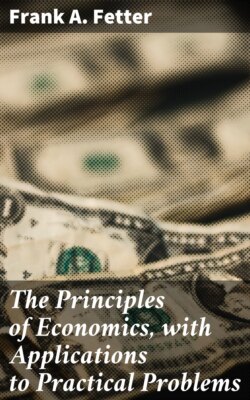Читать книгу The Principles of Economics, with Applications to Practical Problems - Frank A. Fetter - Страница 25
На сайте Литреса книга снята с продажи.
§ II. DEMAND FOR GOODS GROWS OUT OF SUBJECTIVE COMPARISONS
ОглавлениеDesire may become demand
1. Demand is desire for goods united with the power to give something in exchange. An example frequently given to show the difference between desire and demand is the hungry boy looking longingly at the sweetmeats in the confectioner's window. He represents desire, but not until the kind-hearted gentleman gives him a nickel does he represent effective demand. Desire, therefore, must be united with power to give something in exchange before it can be called demand. It must be for something that is attainable; yearning for something beyond reach, sighing for the moon, is desire that never can become effective demand.
Demand the Social expression of shifting choice
2. Demand is the social aspect of the individual man's comparison of utilities. It is the expression of the man's wish to substitute some of his goods for some one else's goods in order to get a higher satisfaction. This comparison is often made between two goods owned in different quantities. When men are constantly comparing things in their own possession, it is a short step to compare their goods with their neighbor's.
Demand for consumption goods is thus the manifestation of the man's desire to redistribute his enjoyments. In demand for goods men virtually say: "Part of what I have I am ready to give for part of what you have." The strength of their desire is expressed by the amount of their offer. When he makes this comparison and this offer, man enters into a social, economic relation with his fellows.
The limit of the exchanger's demand
3. The law of individual demand is: The trader will reduce his stock of a particular good to the point where its marginal utility equals that of the alternative goods. The greater the divergence in his estimates of the marginal utilities of two goods, the more ready is he to trade the lower utility for the higher one. Exchange is but the effort to adjust goods to wants in the best way. The less useful (marginally viewed) is traded for the more useful. The greater the difference, in the one trader's judgment, between the marginal utilities of the two goods, the greater is the maladjustment, and the greater, therefore, is the motive to seek readjustment by means of exchange. As the quantity of the good parted with declines, its marginal utility increases; and as more of the other good is acquired, its marginal utility declines. The marginal utility of the two exchangeable units must come to equilibrium in the individual's judgment. At this point demand ceases, not because an additional unit of the one good could afford no gratification, but because it would afford less gratification than the other good in which demand must be expressed to be effectual.
The Demand curve
4. Demand thus varies at different ratios of exchange between goods, and may be expressed graphically by a demand curve. This would show for any one man the decline of the marginal utility of each added portion of a good, and these individual demand curves may be united into a demand curve for a group of men. The demand curve expresses graphically what a man would be willing to pay at each particular stage in the increase of goods. We have here come to the very threshold of the subject of markets and exchange.
Elasticity of demand
5. Elasticity of demand, in the case of any good, expresses the degree in which a change in its ratio to other goods will increase the demand. Elasticity varies for different classes of men according to their wealth and to the cost of the goods. If strawberries are a dollar a box in the city market, a slight fall in the price, say to seventy-five cents, will increase the demand but slightly. But if the price is fifteen cents and falls to ten, the increase in the demand will be marked, for the number of consumers to whom a difference of five cents is important is then very great. The demand for the staples is comparatively inelastic. A certain amount of simple food is necessary to support life; an increase in its price will not quickly check the demand. On the other hand, if the price of staple foods falls, no very great increase will take place in the demand.
